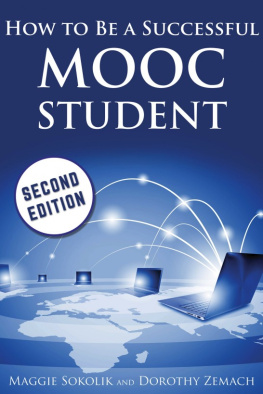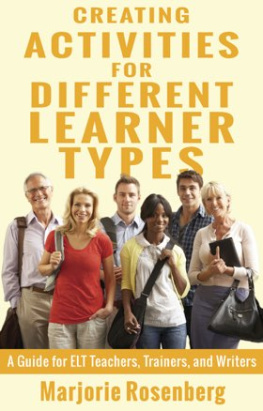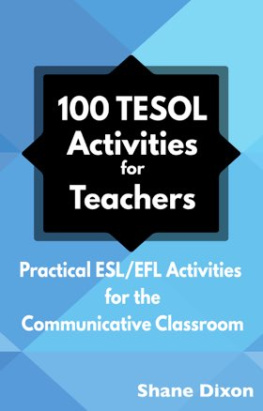Fifty Ways to Teach Grammar
Tips for ESL/EFL Teachers
Maggie Sokolik
50 Ways to Teach Grammar: Tips for ESL/EFL Teachers
Copyright 2014; revised 2018 by Wayzgoose Press
All rights reserved. No part of this publication may be reproduced, stored in or introduced into a retrieval system, or transmitted, in any form, or by any means (electronic, mechanical, photocopying, recording, or otherwise) without the prior written permission of the copyright owner. Dramatic works contained within this volume are intended only as reading material, and their inclusion does not imply the granting of performance licenses, which must be arranged through the author.
Edited by Dorothy E. Zemach. Cover design by DJ Rogers.
Published in the United States by Wayzgoose Press.
Foreword
Most teachers use a textbook in class, which provides both instruction and practicebut, often, not enough practice. Students need to practice again and again, and in different ways, not just to keep their interest but to both learn and remember.
This book gives you ideas to help your students practice grammar in English. It can be used with any textbook, or without any textbook at all. It tells you how to adapt and extend exercises; it gives you prewriting, topics, and revision activities that can be added to any class.
Not every idea will work for every student or for every class. Thats why there are fifty. We feel sure that many of the ideas presented here will bring you results if you try them sincerely and practice them regularly.
Here is a suggested method for using this book:
- Read through all of the fifty tips without stopping.
- Read through the tips again. Choose five or six that you think might work for your class. Make some notes about what you think is useful in each, and why. Decide when you will try them.
- Choose different types of ideas. Try some that can be done independently, and some that work along with your textbook or other course materials.
- Each time you use one of the tips, make a note about how well it worked for you and why. Remember that most of the tips will work best if you use them several times (or even make them a habit). Dont try a tip only once and decide its no good for your students. Give the tips you try at least a few chances, perhaps varying them in some way to address any previous problems you might have had with your students.
- Every few weeks, read through the tips again, and choose some new ones. Discontinue using any methods that are not working for you and your students.
Finally, consider trying some of the other books in our 50 Ways to Teach series. No one skill in English is really separate from the others. Speaking, listening, reading, writing, vocabulary, and grammar are all connected. Students who improve in one area will almost always improve in other areas, too. The series includes special volumes for teaching young learners, teenagers, and for using technology in the classroom.
Introduction
This book is for instructors who are new to teaching ESL/EFL, new to teaching English grammar, or are simply looking for more creative and engaging grammar activities for their English classes.
The materials here are not a presentation of research and pedagogical methods, but a list of activities and tips for making these activities more effective. Many of the ideas are based on a communicative approach to grammarthat is, grammar as it is actually used in speech and writing, not just as a list of rules to memorize and follow.
Of course, not all these tips may work for your class exactly as written. It is always beneficial to consider an idea and think about how you could adapt it to your own context.
When you read a tip, think about how you might change it to fit your students ages, levels, cultural backgrounds, and interests. You might also try completing the task described in the tip yourself before using it with students. This will help you anticipate questions your students might have, or know in advance how long it might take for them to complete it. Of course, you should feel free to adapt the activities in any way you like.
This book is divided into three categories:
- Reading and Writing Exercises
- Listening and Speaking Activities
- Fun and Games
In adapting these exercises, you might discover that some speaking exercises could be done in writing, or some writing exercises might make good speaking exercises. Dont feel constrained by these categories. You might also find that some activities can be adapted for different grammar points. Think creatively, and experiment!
An important note: While some teachers (and students) may dismiss games and puzzles as not being serious enough for their classrooms, there is plenty of evidence that these types of activities improve vocabulary and memory. They can also decrease the stress of learning, and help students engage with each other in authentic communication.
Even if youre resistant to using games and puzzles, we encourage you to give them a try. Many games are, after all, a type of drilla fun way to practice intensively.
Finally, whether you are using this book as part of a grammar course, or you are using grammar instruction as part of a multi-skills course, you should find something useful here. If you have ideas or amendments to the tips here, please send them to us at editor@wayzgoosepress.com for consideration in future editions.
You can find the worksheets to use with some of the tips at: anglofile.com/50ways/ . You are free to photocopy and distribute these worksheets.
I
Reading-Writing Activities: Low Level
As part of grammar instruction, reading and writing activities provide some of the most flexible ways to help students build their skills and understanding.
Reading and writing activities can be used for homework, for individualized instruction, or as whole-class activities. They can be done quietly as seat work, or in small groups in gap-fill or problem-solving activities, giving your students speaking and critical-thinking opportunities as well.
The reading-writing activities here present a number of different ways of integrating grammar into your class. Some of them may look familiar, or similar to things youve tried. Others may be completely new to you.
We all know that students often feel that grammar is boring or useless. The goal of the activities in this section, and the sections to come, is to show students that learning grammar can be engaging and fun.
The following tips are suitable for all levels of students, but may be particularly appropriate for lower-level students.
Photograph Prompt
This activity focuses on using the present progressive.











